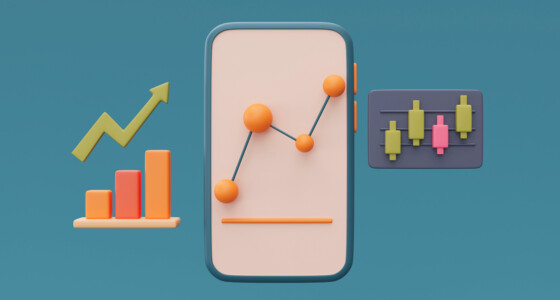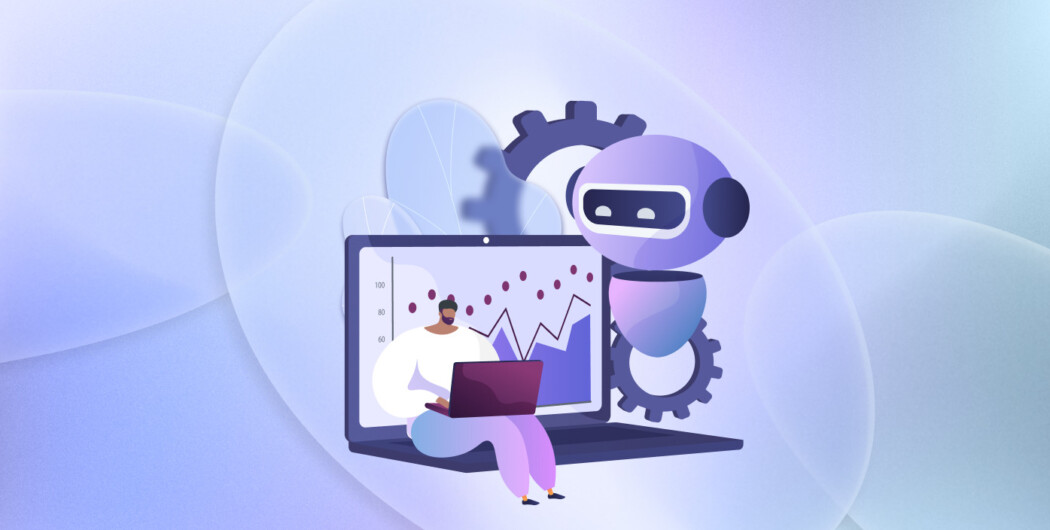

ChatGPT, a groundbreaking language model, took the world by storm, captivating over one million users within just five days of its release. The language generation abilities of ChatGPT have been put to use in creating poetry, storytelling, writing code, and even composing music.
Now, imagine harnessing this AI tool to craft trading strategies and using them on Binomo. But don’t get too greedy — ChatGPT is not a magical cure-all solution for all your trading challenges. However, what if the ChatGPT trading approach can become a powerful companion to traditional trading methods? Let’s see if leveraging the tool’s language generation capabilities for trading achievements is possible.
What is ChatGPT?
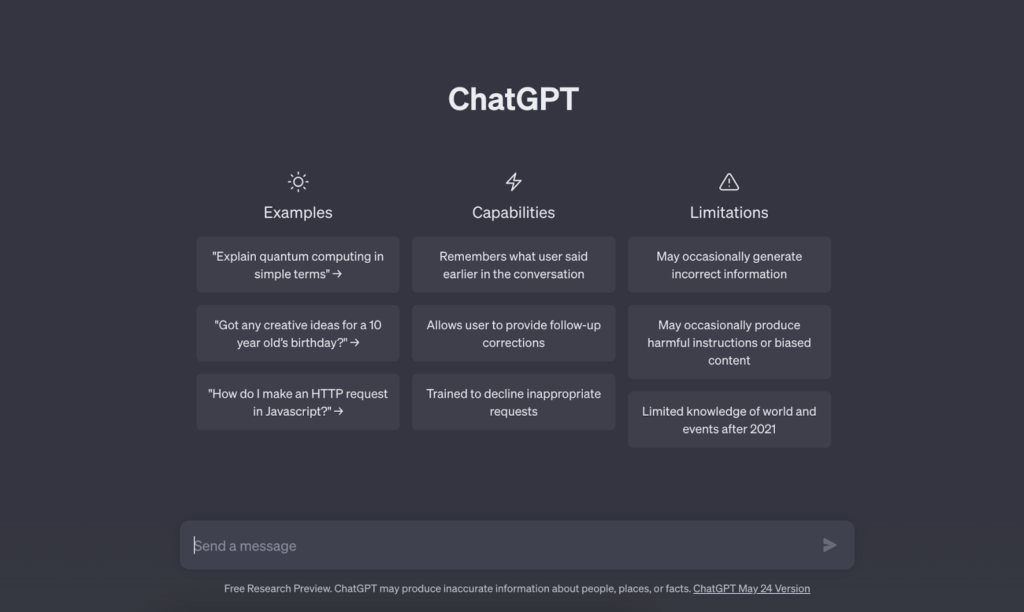
ChatGPT is an artificial intelligence chatbot launched on November 30, 2022. It’s a natural language processing tool powered by AI technology, which can engage in human-like conversations and perform various tasks. The dialogue format allows the chatbot to handle follow-up questions, acknowledge errors, challenge false assumptions, and decline inappropriate requests.
According to an analysis by Swiss bank UBS, ChatGPT has experienced unparalleled growth, becoming the fastest-growing ‘app’ of all time. The analysis estimates that within just two months of its launch, ChatGPT amassed an impressive 100 million active users. To put this into perspective, popular platforms like TikTok took nine months to reach the same user milestone.
OpenAI, the organization behind ChatGPT, has also been responsible for creating other notable AI projects, such as DALL-E 2, a widely-known AI art generator, and Whisper, an automatic speech recognition system.
Limitations of ChatGPT
One crucial aspect is that ChatGPT’s database is based on materials up to September 2021. So, like any AI-driven trading system, ChatGPT faces challenges due to its lack of real-time data access. If you want to make timely trading decisions, the knowledge cutoff will hinder that ability, especially in fast-moving markets where up-to-the-minute information is crucial.
Additionally, while ChatGPT exhibits impressive language capabilities, it sometimes falls short of fully understanding the context of complex financial concepts or market dynamics. This may, unfortunately, result in inaccurate or incomplete responses. Similarly bad responses can come from data that contains biases or noise, and there is no guarantee that the tool was trained on 100% accurate datasets.
Moreover, ChatGPT provides general responses and recommendations without considering individual traders’ risk tolerance, financial goals, or trading preferences. And lastly, employing AI models like ChatGPT in trading raises legal and compliance considerations; for example, in the case of algorithmic trading regulations.
Should you pay to make a trading strategy?
OpenAI offers both free and paid versions of ChatGPT, with the core service for ChatGPT Plus granting access to the more advanced GPT-4 model at a cost of $20 per month.
Subscribing to ChatGPT Plus helps you avoid being bumped out of the chatbot during peak usage hours. However, users should be aware that there may be occasional outages that could lead to temporary loss of access for everyone. Also, the current iteration of GPT-4 still takes longer to respond to prompts compared to GPT-3.5.
The paid version, GPT-4, is touted to be more advanced than its predecessor, offering improved accuracy in written answers and more sophisticated language generation capabilities. Although it still may make occasional errors, known as “hallucinations,” the advancements have been praised by some experts (e.g., ZDNET’s Steven Vaughan-Nichols).
Of course, if you’re new to this, start with the free version of ChatGPT.

How to write a ChatGPT prompt the right way
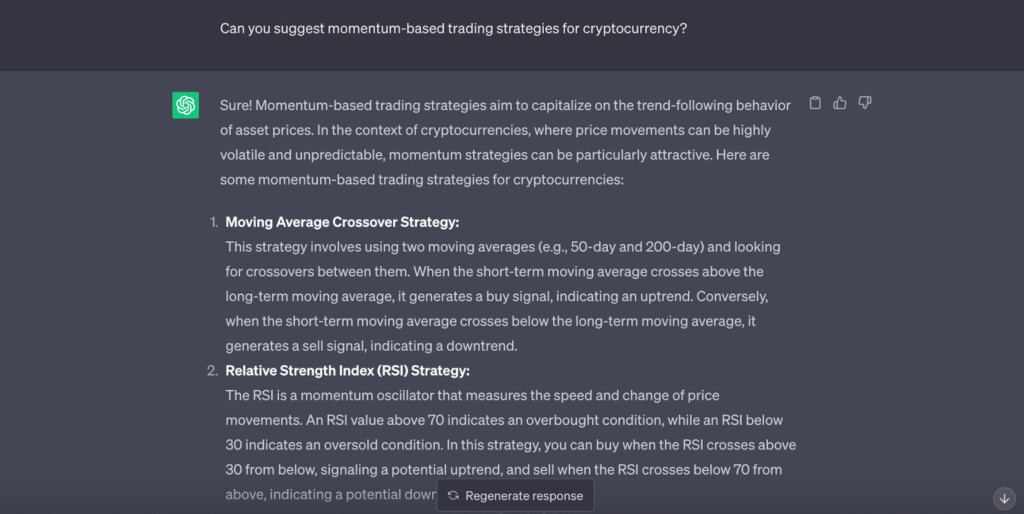
Using ChatGPT for trading, specifically formulating prompts, requires a balance of simplicity, specificity, and creativity. Here’s a list of rules to follow:
Keep it simple
- Bad prompt: Please provide a detailed analysis of the stock market for the next year.
- Good prompt: What are the current trends in the technology sector?
Be specific
- Bad prompt: Tell me about profitable trading strategies.
- Good prompt: Can you suggest momentum-based trading strategies for cryptocurrency?
Use keywords:
- Bad prompt: What’s a good time to sell my investments?
- Good prompt: What are the key factors to consider when timing an exit strategy for long-term investments?
Be creative:
- Bad prompt: What is the current price of AAPL stock?
- Good prompt: Imagine a scenario where a major tech company announces a breakthrough innovation. How might that impact the stock price?
Include context:
- Bad prompt: “Should I buy Tesla?”
- Good prompt: “Considering the historical performance of the Tesla stock, what are the pros and cons of investing in Tesla?”
Specify timeframe:
- Bad prompt: How will the economy perform?
- Good prompt: In the next five years, how do you think the economy will perform given historical background ?
Avoid ambiguity:
- Bad prompt: Tell me about market trends.
- Good prompt: What are the market trends in renewable energy stocks?
Asking to explain different trading concepts
When trading with AI, you have the opportunity to delve into various trading concepts, and ChatGPT can be your guide in exploring these topics. Based on the insights and explanations you receive, you will then be able to build your own trading strategy.
- “Explain different types of indicators used in trading? Please provide insights into moving averages, relative strength index, stochastic oscillator, and other essential indicators. Also, help me understand how to interpret their signals for potential buy or sell opportunities.”
- “Walk me through common chart patterns like head and shoulders, double tops/bottoms, triangles, and flags.”
- “Differentiate between technical analysis and fundamental analysis in trading.”
- “I have an interest in cryptocurrency trading. Could you explain specific concepts related to crypto trading, such as decentralized finance, blockchain technology, and altcoin trading strategies?”
Asking to make a list of the most effective trading strategies
As you can probably guess, you need to frame the request clearly to receive a comprehensive and well-rounded response. For example:
“I would like to explore a list of the most effective trading strategies used by day traders in forex. Please include a diverse range of strategies that have demonstrated positive results in various market conditions. Briefly explain the principles and potential benefits of each strategy to help me understand their key concepts. Additionally, highlight any specific risks or limitations associated with each strategy.”
Please note that it’s always beneficial to cross-reference the information with other reliable sources.
Asking to provide the most effective strategy based on specific criteria
Now, you can go to an even more granular level with your ChatGPT trading strategy. Here’s a prompt you can use as a follow-up:
“Considering the list of effective trading strategies provided earlier, make [this one] more accurate for my trading needs. Please tailor it to the following criteria:
- Asset: [the asset or financial instrument you want to trade, e.g., BTC/USD, AAPL, EUR/USD, etc.]
- Timeframe: [the trading timeframe you prefer, such as daily, hourly, or any specific interval]
- Risk tolerance: [your risk tolerance level, e.g., conservative, moderate, aggressive]
- Additional preferences: [any other preferences you have, such as specific technical indicators or chart patterns you want to include in the strategy]
Provide details and any specific rules and guidelines.
Asking for specific points
Next up, it’s essential to further clarify the details of the strategy to determine specific entry points, stop loss levels, and take profit targets.
- Entry points: [the exact entry points for opening a trade. It could be a specific price level, a combination of technical indicators reaching certain values, or a confirmed chart pattern]
- Stop loss: [the maximum acceptable loss you are willing to incur per trade]
- Profit targets: [your desired profit targets or percentage gains]
If there are any other important parameters or rules that need to be followed to execute the strategy successfully, please include them. For instance, mention any specific conditions that may invalidate the trade setup.
Asking to write a script for automated trading
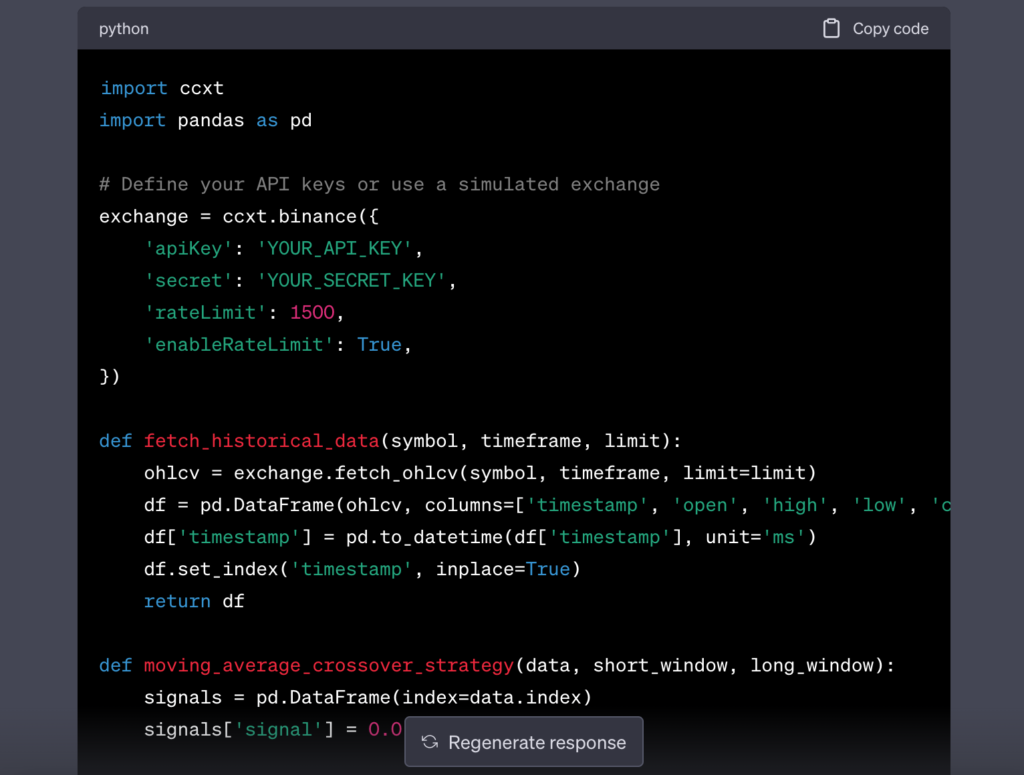
If you want ChatGPT to write a strategy script for an automated trading plan, provide clear instructions and specify the parameters and trading conditions you want to be included. Here’s an example of how you can make the request:
Please create a basic automated trading strategy script with the following parameters and trading conditions:
- Strategy type: Moving Average Crossover
- Timeframe: Daily
- Trading pair: BTC/USD
- Buy condition: When the 50-day moving average crosses above the 200-day moving average
- Sell condition: When the 50-day moving average crosses below the 200-day moving average
- Stop loss: Set at 3% below the entry price
- Take profit: Set at 5% above the entry price
- Risk management: Allocate 2% of the total account balance for each trade
Please ensure that the script can handle multiple indicators and is adaptable to various trading scenarios. Feel free to include any additional considerations you deem necessary for an effective strategy.
Backtesting strategies
The fact that ChatGPT generates answers based on its knowledge cutoff in September 2021 is painfully relevant. With no access to real-time market data, recent events, and developments, the precision of backtesting and the effectiveness of strategies can be severely compromised.
And as mentioned, ChatGPT’s responses can be influenced by incorrect or outdated information present in its training data. While efforts have been made to ensure accuracy, errors and outdated data may still exist. So, if you generate a trading strategy using ChatGPT, it’s essential to conduct thorough backtesting on a real trading platform.
How to teach ChatGPT
When you first teach ChatGPT a trading strategy, it absorbs the information you provide, like a person learning a new concept or skill. This could be explaining the strategy, its components, and how it’s applied in real-world scenarios. After learning about the strategy, the tool attempts to apply it to the test scenario or historical data you provided.
If the chatbot’s analysis is accurate, it reinforces its understanding of the strategy. However, if there are errors or misconceptions, you provide feedback to correct and guide it. As you provide more input and feedback, ChatGPT refines its understanding of the strategy over time. Basically, the chatbot’s knowledge and analytical capabilities improve with each iteration.
Be cautious of unintentionally reinforcing biased responses. If you notice any biased outputs, provide counterexamples and promote a balanced perspective in your teaching. And when possible, demonstrate desired responses to guide ChatGPT’s behavior.
What are the advantages of using ChatGPT?
Among the notable advantages of using AI for trade, including ChatGPT, are:
- Versatility of applications
- Advanced pattern recognition
- Reduced emotional bias
- Ability to process information much faster than humans
- 24/7 availability
- Multilingual support
Using GPT or any AI model for trading is as effective as the person operating the model. Just as a skilled worker is essential for operating manufacturing equipment efficiently, a trader’s expertise in financial markets is crucial for using GPT properly.
Continuing with the analogy, equipment produces high-quality products if the operator sets the right parameters and follows a well-designed production process. Similarly, traders must carefully craft their prompts and make necessary adjustments to ensure optimal results. Only then will they enjoy the benefits of automation.
Final thoughts
Some of the traders’ experiences with ChatGPT have been impressive. Through a few simple prompts, it’s possible to stumble upon a rather profitable trading strategy that may even outperform the traditional buy-and-hold approach. Similarly, you can seek explanations, receive suggestions, or create shortlists of potential trading strategies for the Binomo platform.
However, it’s important to note that positive results aren’t instant nor effortless. It takes a diligent effort to experiment, refine, and fine-tune the prompts and strategies to arrive at the winning formula. As with any tool, ChatGPT’s capabilities are maximized when combined with human expertise and critical thinking.
By combining the strengths of AI and human ingenuity, there are ways to discover exciting possibilities in the realm of finance and beyond. Just keep writing the right prompts and experimenting!
Sources:
Introducing ChatGPT, OpenAI
How to use ChatGPT: Everything you need to know, ZDNET








